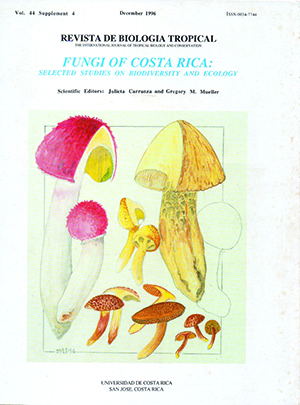Abstract
On the basis of more than 430 collections of Costa Rican smut fungi (Ustilaginales and Tilletiales, Basidiomycetes) and literature, 53 different smut species in 18 genera are listed for the country. Tilletia ayresii on Panicum maximum is the most frequently collected smut. Apart from some other frequent species, many smut species have rarely been found, though their host plants are frequently met. Most of the smut infections were found on herbaceous hosts (Poaceae and Cyperaceae), in rural vegetation, during the rainy season until the beginning of the dry season. On Cyperaceae, Anthracoidea and Farysia species occur in the highlands while species of Cintractia are mostly restricted to the lowlands. Cintractia limitata has only been found below 600 m in Costa Rica, though its host, Cyperus rotundus, has been observed frequently at about 1200 m. The distribution of certain smut species and genera shows affinities between the vegetation in tropical highlands and vegetation in temperate climate. Smuts are rarely found on active volcanoes, perhaps because of volcanic air contamination.
References
Bernhardt, K.-G. & M. Koch. 1994. Eingeführte Pflanzen aus Europa als Bestandteil der Vegetation Costa Ricas (Zentralamerika). Bauhinia 11(2): 121-127.
Clinton, G. P. 1902. No1th American Ustilagineae. J. Mycol. 8: 128-156.
Davidse, G. M. Sousa S. & A. O. Chater (eds.). 1994. Flora Mesoamericana, vol. 6, Alismataceae a Cyperaceae. Universidad Nacional Autónoma de México, México. 543 p.
Durán, R. & G. W. Fischer. 1961. The genus Tilletia. Washington State University, Washington. 138 p.
Gamboa, V. C. S. 1989. lndice de enfermedades de los cultivos agrícolas de Costa Rica. Ministerio de Agricultura y Ganadería, Dirección de Sanidad Vegetal, San José, Costa Rica.
Hammel, B. & M. Grayum in collaboration with the lnstituto de Biodiversidad and the Museo Nacional de Costa Rica. 1994. Manual de las Plantas de Costa Rica, Especies ldentificadas. San José, Costa Rica.
Hennen, J. F. & J. W. McCain. 1993. New species and records of Uredinales from the Neotropics. Mycologia 85: 970-986.
Ling, L. 1951. Taxonomic notes on the Ustilaginales. Lloydia 14: 101-110.
Macey, A. 1975. The vegetation of Volcan Poas National Park, Costa Rica. Rev. Bioi. Trop. 23: 239-255.
Nannfeldt, J. A. 1979. Anthracoidea (Ustilaginales) on Nordic Cyperceae-Caricoideae, a concluding synopsis. Symb. Bot. Upsalienses 23: 3, p. 1-41.
Piepenbring, M. 1994. Brandpilze (Ustilaginales und Tilletiales) von Costa Rica; Ökologie, Morphologie, Ultrastruktur und Systematik. Doctoral thesis, Eberhard Karls-
Universität, Tübingen, Germany. 364 p.
`````````Piepenbring, M. 1995. Taxonomic studies on Ustilaginales from Costa Rica. Mycol. Res. 99: 783-788.
Piepenbring, M. 1995a. Trichocintractia, a new genus for Cintractia utriculicola (Ustilaginales). Can. J. Bot. 73: 1089-1096.
Piepenbring, M. 1996. Smut fungi (Ustilaginales and Tilletiales) in Costa Rica. Nova Hedwigia Beih. 113: 1-155.
Piepenbring, M., K. Vánky & F. Oberwinkler. 1995. Aurantiosporium, a new genus of Ustilaginales. Pl. Syst. Evol. 199: 53-64.
Scholler, M. & M. Schubert. 1993. Beitrag zur Pilzflora des Peenetals bei Gützkow (Mecklenburg-Vorpommern). Z. Mycol. 59 (2): 165-180.
Sydow, H. 1925. Fungi in itinere costaricensi collecti. Pars prima. Ann. Mycol. 23: 308-429.
Sydow, H. 1926. Fungi in itinere costaricensi collecti. Pars secunda. Ann. Mycol. 24: 283-426.
Vakili, N. G. 1978. Distribution of smut of beans and cowpeas in tropical America and its possible centre of origin. F. A. O. Pl. Protect. Bull. 26: 19-24.
Vánky, K. 1992. Taxonomical studies on Ustilaginales. IX. Mycotaxon 43: 417-425.
Vánky, K. 1992a. K. Vánky, Ustilaginales exsiccata. Fasc. XXXIII-XXXVI (No. 801-900). Publications from the Herbarium Ustilaginales Vanky (HUV) 8: 1-34.
Vánky, K. 1993. Taxonomical studies on Ustilaginales. X. Mycotaxon 48: 27-44.
Vánky, K. 1994. Taxonomical studies on Ustilaginales. XI. Mycotaxon 51: 153-174.
Vánky, K. & R. Bauer. 1992. Conidiosporomyces, a new genus of Ustilaginales. Mycotaxon 43: 426-435.
Vánky, K. & F. Oberwinkler. 1994. Ustilaginales on Polygonaceae a taxonomic revision. Nova Hedwigia Beih. 107: 1-96.
Ward, H. M. 1887. On the structure and life-history of Entyloma Ranunculi (Bonorden). Philos. Trans. Roy. Soc. London, Ser. B, 178: 173-185 + Pls. 10-13.
Webster, J. 1988. Botany and mycology, p. 157-180. In W. Breuter & B. Zimmer (eds.). Proceedings of the XIV international Botanical Congress. Koeltz,
Königstein/Taunus, Germany.
Zundel, G. L. 1953. The Ustilaginales of the World. Pennsylvania State ColL. School Agric. Dept. Bot. Contrib. 176: XI+1-410. Mycotaxon 51: 153-174.
##plugins.facebook.comentarios##

This work is licensed under a Creative Commons Attribution 4.0 International License.


